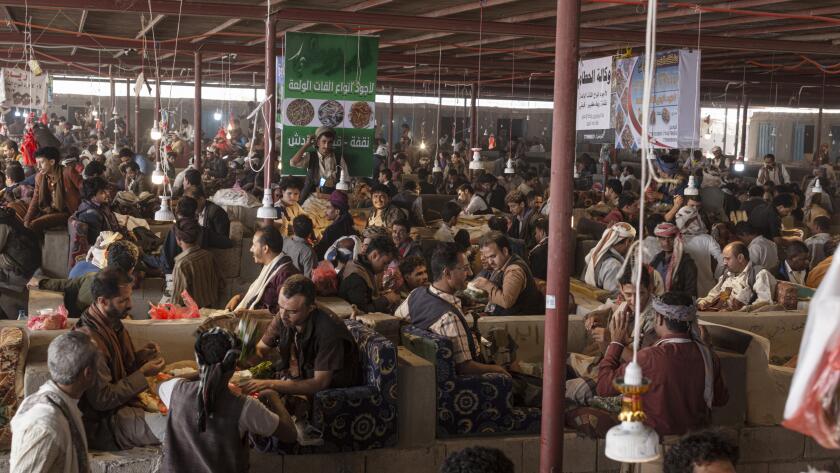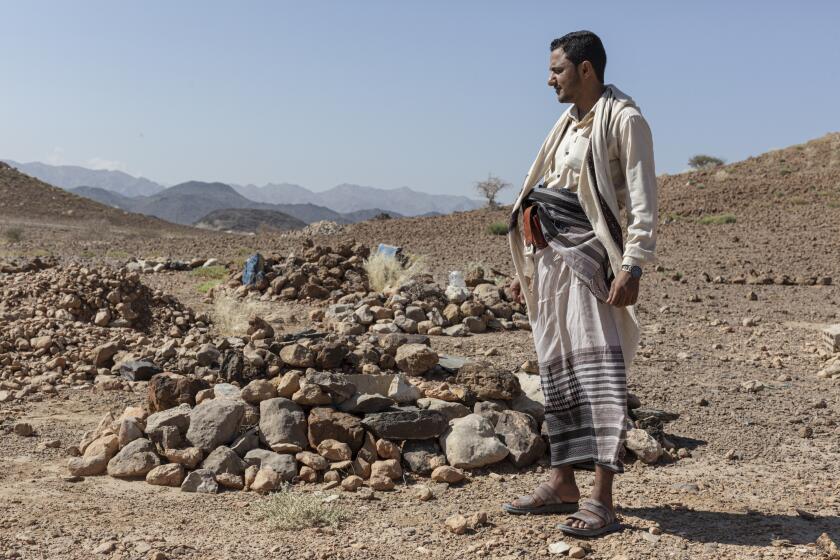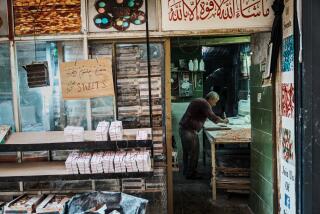A small narcotic leaf brings big comfort — and big business — to war-weary Yemenis
- Share via
Some call it cure, many call it curse. Still, khat is Yemenis’ main pastime.
- Share via
ATAQ, Yemen — It can be as early as 7 in the morning, or 10, or as late as 2 p.m. It doesn’t matter. Whenever the khat market opens, customers come.
It draws them like a magnet to the run-down edge of this desert city. There you’ll find Al-Ajar market, a cinder-block husk of a warehouse where dozens of merchants assemble to sell the leafy plant that is Yemen’s most popular narcotic.
And make no mistake, khat is popular. What in decades past was an occasional indulgence for the country’s rich has become, one study says, a near-daily habit for a staggering 90% of the population — including men, women and children as young as 12.
Other studies dispute that figure, but even the most cursory look around suggests it’s not far off the mark. Come afternoon, it seems that almost everyone hunkers down for marathon sessions of khat chewing, their eyes turning red and glassy from its initial amphetamine-like high, their cheeks bulging with a growing bolus of leaves picked fresh from the shrub.
Everywhere around you: Pluck. Chew. Swallow.
Repeat.
All that khat makes for big business, no small feat in a country where the gross domestic product and currency have halved in value since a devastating civil war began in 2014, and where 85% of the population needs aid, according to a 2020 government report. Khat — also known as Catha edulis, or qat — is Yemen’s top cash crop, its cultivation the main livelihood for most of the 37% of the population working in agriculture, according to the U.N.’s Food and Agriculture Organization.
“Fighter? No. I’d prefer to be a khat merchant than go fight,” says Musheer Sadeq Shamiri, a portly 35-year-old khat trader installed on his perch in the Ajar market.
“I work in khat because it’s the best work I can get. It’s easier than working in anything else. For poor people it’s the best option.”
That may be, but critics also cite it as a primary driver of the country’s many ills because of its drain on both human and natural resources, such as water. For them, khat’s widespread use is a burden that Yemenis can ill-afford.
Yet many certainly try. On any given day, Shamiri says he’ll sell from 150 to 175 pounds of khat, doling out bundles of fresh-looking green sprigs wrapped in red plastic baggies. If there’s a social occasion, like a festival or a wedding, sales are double that amount.
How much khat do you have to chew for it to have an effect? Shamiri says for most people it’s a bagful.
“Some need more. My uncle? He could take seven bags,” Shamiri says with a kind of awe.
Like most merchants here, Shamiri routinely gets high on his own supply. That has made him a khat connoisseur, able to pick out the right variant for the right mood.
“It’s like honey. I know all the different types,” he says. He brandishes two differently marked bundles of khat, offering a leafy twig from each in quick succession to a visiting reporter.
“This one makes you focus. This one? It’ll take you offline.”
Weakened by war, Yemen’s government is barely functioning, but that has allowed creative local leaders to thrive — and perhaps show the way forward.
Getting supplies of the different varieties isn’t difficult. Even though khat grows exclusively in Yemen’s northern regions, where Houthi rebels hold sway, trucks laden with the crop cross battle lines every day, making deliveries with little trouble to areas controlled by the Yemeni government or to a different group of separatists in the south.
“You’ll have people fight the Houthis in the trenches, but then they’ll go buy khat sold from Houthi areas,” says Amar Aulaqi, deputy minister of water and environment, adding that the front lines are always quiet during chewing times. “Between noon and 4 p.m, there’s an undeclared truce in Yemen.”
The government also benefits from khat as a prime source of taxation. In Ataq, the capital of Shabwa province, khat contractors pay 5 million Yemeni rials (about $6,300) a day to the local government from taxes paid on every baggie sold. That’s a significant windfall in a country where many residents live on less than $2,200 a year.
Though khat is a nightmare for the coronavirus-conscious — most people enjoy it in groups, stuffing their mouths for hours with leaves from shared bags or bundles and spitting and lounging around in close proximity — the pandemic hasn’t dulled demand. Quite the opposite: Ataq had to shut down the old market in the center of town because it got too crowded, making social distancing impossible.
“The market stopped because of corona, so for three months we sold khat out of our trucks in the desert,” Shamiri says.
Later, the local government opened up two khat markets, including Al-Ajar. But they, too, are only temporary; there are now plans to build a new, more spacious central market in downtown Ataq.
Despite a civil war and the COVID-19 pandemic, Yemen remains a crossing point for tens of thousands of East African migrants headed for Saudi Arabia.
All that would make it appear that khat use is not only tolerated but encouraged. Yet the government has cause for some alarm.
Khat’s cultivation increasingly dominates the 2.3% of arable land in Yemen, crowding out other crops in a country where hunger and malnourishment are widespread. Detractors also say it fuels the war by putting money in the combatants’ coffers, and because it’s a thirsty plant, requiring deep-well irrigation and disproportionate use of water, it exacerbates the country’s water scarcity. And because it’s illegal in most countries, it can’t be exported, although that matters less when 97% of locally produced khat is bought and consumed domestically.
“It was even discussed to bring khat from Ethiopia. Since we’re paying, we might as well get it from there where there’s more water,” Aulaqi said.
Meanwhile, nongovernmental organizations and other aid groups point out the obvious: that sitting for hours and chewing the leaf may not be the most productive use of time. It’s also a drain on household finances, with many people spending more money on feeding their khat habit than on feeding their families.
News Alerts
Get breaking news, investigations, analysis and more signature journalism from the Los Angeles Times in your inbox.
You may occasionally receive promotional content from the Los Angeles Times.
Efforts to eradicate it have mostly failed. The only group that came close to succeeding was Al Qaeda in the Arabian Peninsula, the Yemeni offshoot of the terror group, which imposed its austere interpretation of Islam on the areas it commandeered in 2016.
Khat’s supporters insist that it isn’t addictive — at least, no more than tea or coffee — and that it actually improves productivity by keeping users awake and focused, a sort of herbal alternative to Ritalin.
Besides, there’s a certain ritual to enjoying khat. It forces you to slow down. The constant chomping induces a languid, literally ruminative mood. It starts as a stimulant but, as the hours go by, mellows and inspires many users to slip into deeper discussions than those they might have in the Arab world’s coffeehouses.
Not everyone agrees on its benignity. No less a figure than the late Mohamad Mahmoud Zubairi, Yemen’s foremost revolutionary and poet, detested the plant, describing khat as a devil that “made the Yemeni people lust after it, and is fighting in their stomachs against valuable nutrients for the human body. Then it runs in their veins like Satan, and enters their pockets to steal their money.”
Zubairi wrote that denunciation in 1958. But he also acknowledged a truth that remains unwavering today: “It is truly the top ruler of Yemen.”
More to Read
Sign up for Essential California
The most important California stories and recommendations in your inbox every morning.
You may occasionally receive promotional content from the Los Angeles Times.
















